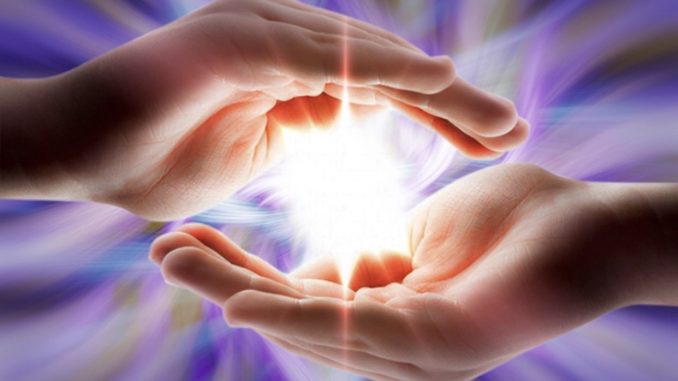
Origins
Reiki is a spiritual practice developed in 1922 by Mikao Usui. After three weeks of fasting and meditating on Mount Kurama, in Japan, Usui claimed to receive the ability of “healing without energy depletion”. A portion of the practice, tenohira or palm healing, is used as a form of complementary and alternative medicine (CAM). Tenohira is a technique whereby practitioners believe they are moving “healing energy” (a form of ki) through the palms.
Teachings
Reiki teachings claim that there is an inexhaustible, universal “life force” spiritual energy, that can be used to induce a healing effect. Believers say that anyone can gain access to this energy by means of an attunement process carried out by a Reiki Master.
Reiki is described by adherents as a holistic therapy which brings about healing on physical, mental, emotional and spiritual levels. The belief is that the energy will flow through the practitioner’s hands whenever the hands are placed on, or held near a potential recipient, who can be clothed. Some teachings stress the importance of the practitioner’s intention or presence in this process, while others claim that the energy is drawn by the recipient’s injury to activate or enhance the natural healing processes. Going further, the belief is that the energy is “intelligent”, making diagnosis unnecessary.
A second level of training, including another initiation, is said to equip the practitioner to perform Reiki treatments from a distance. This method, it is stated, involves the use of special symbols to form a temporary connection between the practitioner and the recipient, regardless of location, and then to send the Reiki energy. Techniques are also taught whereby Reiki can be sent to a specific point in time, either in the past or the future.
Practice
Whole Body Treatment
In a typical whole-body Reiki treatment, the practitioner asks the recipient to lie down, usually on a massage table, and relax. Loose, comfortable clothing is usually worn during the treatment. The practitioner might take a few moments to enter a calm or meditative state of mind and mentally prepare for the treatment, that is usually carried out without any unnecessary talking.
The treatment proceeds with the practitioner placing his hands on the recipient in various positions. However, practitioners may use a non-touching technique, where the hands are held a few centimeters away from the recipient’s body, for some or all of the positions. The hands are usually kept still for 3 to 5 minutes before moving to the next position. Overall, the hand positions usually give a general coverage of the head, the front and back of the torso, the knees and feet. Between 12 and 20 positions are used, with the whole treatment lasting 30 minutes to 1 hour.
Some practitioners use a fixed set of hand positions. Others use their intuition to guide them as to where treatment is needed, sometimes starting the treatment with a “scan” of the recipient to find such areas. The intuitive approach might also lead to individual positions being treated for much shorter or longer periods of time.
It is reported that the recipient often feels warmth or tingling in the area being treated, even when a non-touching approach is being used. A state of deep relaxation, combined with a general feeling of well-being, is usually the most noticeable immediate effect of the treatment, although emotional releases can also occur. As the Reiki treatment is said to be stimulating natural healing processes, instantaneous “cures” of specific health problems are not usually observed. A series of three or more treatments, typically at intervals of 1 to 7 days, is usually recommended if a chronic condition is being addressed. Regular treatments, on an on-going basis, can be used with the aim of maintaining well-being. The interval between such treatments is typically in the range of 1 to 4 weeks, except in the case of self-treatment when a daily practice is common.
Localized Treatment
Localized Reiki treatments involve the practitioner’s hands being held on or near a specific part of the body. Recent injuries are usually treated in this way, with the site of injury being targeted. There is great variation in the duration of such treatments, though 20 minutes might be typical.
Some practitioners use localized treatments for certain ailments, and some publications have tabulated appropriate hand positions. However, other practitioners prefer to use the whole body treatment for all chronic conditions, on the grounds that it has a more holistic effect. Another approach is to give a whole body treatment first, followed by a localized treatment.
Training
The teaching of Reiki outside of Japan is commonly divided into three levels, or degrees.
First Degree
The first degree Reiki course teaches the basic theories and procedures. Four “attunements” are given to the student by the teacher. Students learn hand placement positions on the recipient’s body that are thought to be most conducive to the process in a whole body treatment. Having completed the first degree course, the participant can treat himself and others with Reiki.
Second Degree
In the second degree Reiki course, the student learns the use of three symbols which are said to enhance the strength and distance over which the effect can be exerted. Another attunement is given, which is said to further increase the capacity for Reiki to flow through the student, as well as empowering the use of the symbols. Having completed the second level, the student can work without being physically present with the recipient.
Third Degree or Master Training
Through the third degree, or “master training”, the student becomes a Reiki Master. (In Reiki terminology, the word “master” does not imply spiritual enlightenment.) One or more attunements are carried out and the student learns a further master-level symbol, called Dai Ko Myo. Having completed the master training, the new Reiki Master can attune other people to Reiki and teach the three degrees of Reiki. The duration of the master training can be anything from a day to a year or more, depending on the school and philosophy of the Reiki Master giving the training.
Variations
There is much variation in training methods, speeds and costs. There is no accreditation body for Reiki, nor any regulation of the practice. Reiki courses can even be taken over the Internet, although Traditionalists state that attunement must be done in person in order to take effect, as the Reiki Master/Teacher doing the attunement must be able to actually touch the energy field of the person being attuned. Some traditionalists maintain that any method that teaches Reiki “quickly” cannot yield as strong an effect, because there is no substitute for experience and patient mastery of the art.


Leave a Reply